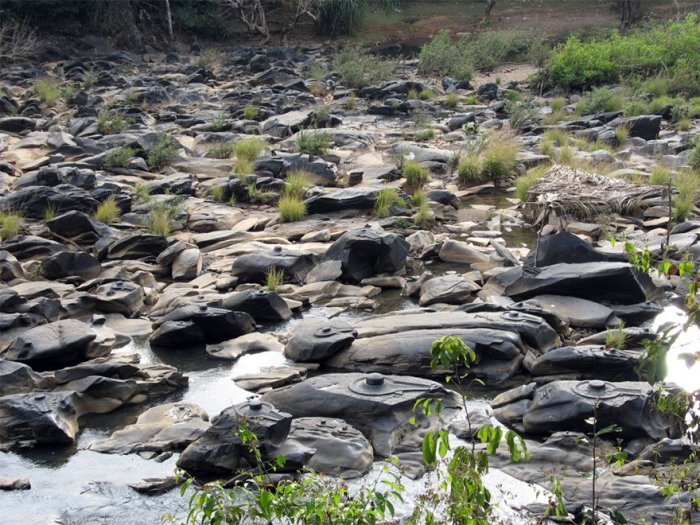Ellen Lloyd - AncientPages.com - It is an astonishing sight to see hundreds of carved Shiva Lingas embedded on the Shalmala river bed. This is an ancient place shrouded in beauty and mystery.
Over 1,000 Astonishing Shiva Lingas Can Be Seen In The Middle Of The Shalmala River
Sahasralinga is a pilgrimage place in the Sirsi Taluk in the district of Uttara Kannada of Karnataka state in India. The river Shalmala is today famous for more than a thousand lingas that are carved on the rocks in the river bank.
Most of the lingas are clearly visible when the water level in the river is not very high. So it shouldn’t be surprising to learn that the name Sahasralinga means thousand-lingas in Sanskrit. It is a sacred site, and during the Hindu festival, Shivratri thousands of pilgrims visit this place and offer pujas.
This magnificent site was discovered in 1969, by an ethnologist named Jean Boulbet. Unfortunately, his work was interrupted by the Cambodian Civil War and it took 20 years before the place was safe to visit.
Recently, due to dry weather, the water level of the Shalmala river in Karnataka receded, revealing the presence of thousands of Shiva Lingas.
According to historians, the lingas are believed to have been commissioned to be carved by Sadashiva Raya (who was also called the King of Sirsi), of the Vijayanagar Kingdom during 1678-1718. There is a local legend that says the Sahasralingas were ordered to be created by the king based on a belief that doing so might help beget an heir to his kingdom.
Many Shiva Lingas Of Unknown Origin Can Be Found In Cambodia
A similar place exists in Cambodia. Cambodian Sahasralinga is located 25 kilometers from Angkor Wat, the largest Hindu temple outside of India.
The place is called Kbal Spean and its meaning is ‘the Head Bridge’. Here, we also find plenty of carved lingas located in the middle of a river, but the place is not sacred and it is rarely visited other than by curious tourists. It should be added it is also difficult to access due to the surrounding wildness.
Long ago the kings used to come here for a holy bath. It is unknown who carved these lingas and for what purpose. Locals believe that the Lingas are symbols of creative energy and the river water that flows on the lingas will make the Cambodian paddy fields more fertile. A lot of Hindu symbols were destroyed during the civil war in Cambodia. But these Sahasra Lingas were not affected because of the surrounding thick forest.
One of the remarkable sculptures here is of Maha Vishnu and Brahma emerges from his belly on a lotus flower.
The Shiva Linga As An Ancient Sacred Symbol
In Sanskrit, Linga means a 'mark' or a symbol, which points to an inference. The Shiva Linga is a representation of the Hindu deity Shiva used for worship in temples. In traditional Indian society, the linga is rather seen as a symbol of the energy and potential of God, Shiva himself.
The idea that the linga represents a phallus is a complete mistake, according to Swami Sivananda, a Hindu spiritual teacher and a proponent of Yoga and Vedanta.
The ancient scripture Linga Purana informs that the foremost Linga is devoid of smell, color, taste, etc., and is spoken of as 'Prakriti' or Nature itself. In the post-Vedic period, the Linga became symbolical of the generative power of Lord Shiva.
The Linga is like an egg and represents the 'Brahmanda' or the cosmic egg.
Linga signifies that the creation is effected by the union of 'Prakriti' and 'Purusha,' the male and the female powers of Nature. Linga also signifies 'Satya,' 'Jnana', and 'Ananta' - Truth, knowledge, and Infinity.
There is a mysterious or indescribable power or 'Shakti' in the Linga, to induce concentration of the mind, and helps focus one's attention. That is why the ancient sages and seers of India prescribed Linga to be installed in the temples of Lord Shiva.
For a sincere devotee, the Linga is not merely a block of stone. It is all-radiant - talks to him raises him above body-consciousness and helps to communicate with the Lord.
Written by - Ellen Lloyd – AncientPages.com
Copyright © AncientPages.com All rights reserved. This material may not be published, broadcast, rewritten or redistributed in whole or part without the express written permission of AncientPages.com
Expand for references








